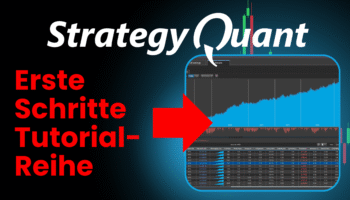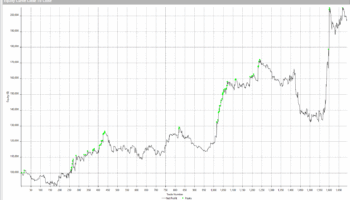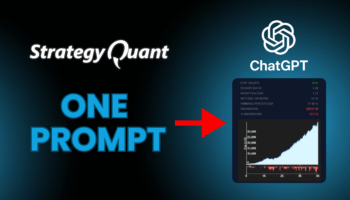Negli ultimi mesi abbiamo aggiunto diversi indicatori tecnici alla nostra base di codifica. Nella scelta di questi indicatori, ci siamo concentrati sulla necessità di garantire che aiutassero gli utenti a identificare meglio i regimi di mercato.
Nella prima parte di questo articolo spiegheremo brevemente cosa sono i regimi di mercato. Nella seconda parte, discuteremo come configurare ciascuno di questi indicatori e come utilizzarli efficacemente durante lo sviluppo della strategia.
Cosa sono i regimi di mercato?
I regimi di mercato sono periodi distinti in cui i mercati presentano proprietà statistiche specifiche. Al di là delle semplici classificazioni "toro" e "orso", i mercati operano in più stati:
- Mercati di tendenza con movimento direzionale persistente
- Mercati in range-bound dove i prezzi oscillano all'interno di confini
- Periodi di alta volatilità caratterizzato da forti oscillazioni di prezzo
- Periodi di bassa volatilità con un movimento minimo dei prezzi
- Spostamenti di correlazione tra strumenti correlati
- Variazioni di liquidità influenzare la qualità dell'esecuzione
Un'intuizione fondamentale per gli utenti dell'StrategyQuant: le strategie ottimizzate per un regime in genere non funzionano quando le condizioni cambiano. Questo spiega perché una strategia redditizia può improvvisamente iniziare a perdere senza alcuna modifica del codice.
Perché le vostre strategie smettono improvvisamente di funzionare
Il fallimento della strategia di solito non è dovuto a una logica errata, ma a cambiamenti di regime del mercato non rilevati. Considerate questi scenari comuni:
- Il vostro sistema di trend-following, che ha funzionato a meraviglia per mesi, accumula improvvisamente perdite quando i mercati diventano instabili.
- La vostra strategia di breakout che ha catturato le mosse più importanti ora si trova di fronte a ripetuti falsi segnali
- Il vostro setup di mean-reversion, che ha prosperato in condizioni di range-bound, viene travolto dall'emergere di forti trend.
Gli indicatori standard come le medie mobili, l'RSI o le Bande di Bollinger di solito non rilevano questi cambiamenti fondamentali finché non si verificano perdite significative. Seguono i sintomi piuttosto che identificare i cambiamenti statistici sottostanti nel comportamento del mercato.
Miglioramento dell'StrategyQuant con l'individuazione di regimi statistici avanzati
Gli utenti della piattaforma StrategyQuant hanno accesso a quattro indicatori statistici avanzati progettati specificamente per l'individuazione dei regimi di mercato:
- Test di Kolmogorov-Smirnov - Rileva cambiamenti statisticamente significativi nella distribuzione dei prezzi.
- Distanza Wasserstein - Misura l'entità degli spostamenti della distribuzione
- CUSUM (Somma cumulativa) - Identifica cambiamenti sottili e persistenti nel comportamento del mercato.
- DTW (Dynamic Time Warping) - Riconosce formazioni di pattern simili indipendentemente dall'allungamento temporale
Questi strumenti valutano aspetti fondamentali del comportamento del mercato che gli indicatori convenzionali non colgono:
- Variazioni nelle distribuzioni di rendimento
- Spostamenti nella struttura temporale
- Somiglianze con i periodi storici
- Persistenza di deviazioni dalle norme stabilite
Applicazioni pratiche in StrategyQuant
Per gli utenti dell'StrategyQuant, questi indicatori possono essere utili in queste situazioni:
- Cambio di strategia - Create blocchi personalizzati nelle vostre strategie che attivano logiche di trading diverse in base ai regimi rilevati.
- Adattamento dei parametri - Regolate automaticamente gli stop-loss, i take-profit e il dimensionamento delle posizioni in base alle condizioni di mercato correnti.
- Allocazione del portafoglio - Spostare il capitale tra le strategie ottimizzate per i diversi regimi
- Backtesting robusto - Testate le strategie su più regimi rilevati per garantire prestazioni coerenti.
- Convalida dei test di avanzamento - Confrontare le condizioni di mercato attuali con i regimi storici per convalidare meglio i risultati dei test previsionali.
Le sezioni seguenti illustrano esattamente come configurare ciascun indicatore all'interno dell'StrategyQuant per rilevare i cambiamenti di regime prima che abbiano un impatto sulla performance di trading.
Indicatori del regime di mercato nella base di codifica StrategyQuant
Nella sezione seguente vedremo come impostare e utilizzare correttamente ciascun indicatore.
Impostazione dell'indicatore del test di Kolmogorov-Smirnov
Il test KS confronta l'azione recente dei prezzi con le distribuzioni storiche per individuare cambiamenti statisticamente significativi. Ecco come impostarlo in modo efficace:
Parametri chiave
Periodo1 (Dimensione del campione recente): Definisce il numero di barre recenti da analizzare.
- Iniziare con 20-30 barre per i grafici giornalieri
- Utilizzare 50-100 barre per i grafici intraday
- Valori più grandi (50-100) forniscono una maggiore fiducia statistica, ma rispondono più lentamente ai cambiamenti
Periodo2 (Dimensione del campione storico): Determina il periodo storico di riferimento.
- Generalmente impostato uguale o superiore a Periodo1
- Un buon punto di partenza è l'impostazione di Period2 = Period1
- Per una maggiore sensibilità ai cambiamenti recenti, rendere il Periodo2 più grande (ad esempio, 2-3 volte il Periodo1).
Soglia del segnale: Il livello di significatività statistica.
- Il valore predefinito di 0,05 (5%) è standard nelle statistiche.
- Valori più bassi (0,01) riducono i falsi segnali, ma potrebbero mancare alcuni cambiamenti di regime.
- Valori più alti (0,10) aumentano la sensibilità ma generano più falsi segnali
Esempi pratici di configurazione
Impostazione conservativa:
- Periodo1 = 50
- Periodo2 = 100
- Soglia segnale = 0,01
- Ideale per: Grafici settimanali o giornalieri, trading a bassa frequenza
Impostazione bilanciata:
- Periodo1 = 30
- Periodo2 = 50
- Soglia segnale = 0,05
- Ideale per: Grafici giornalieri, swing trading
Impostazione reattiva:
- Periodo1 = 20
- Periodo2 = 30
- Soglia del segnale = 0,10
- Ideale per: Grafici intraday, segnali più frequenti
Linee guida per l'interpretazione
- Quando il valore dell'indicatore è 1, suggerisce un cambiamento di regime statisticamente significativo.
- Cercare segnali persistenti (più 1 consecutivi) piuttosto che istanze isolate.
- Combinazione con altri indicatori per confermare il cambiamento
È possibile scaricare l'indicatore e i blocchi personalizzati qui.
Impostazione dell'indicatore di distanza Wasserstein
La distanza di Wasserstein misura la dissimilarità tra le distribuzioni dei prezzi recenti e quelle storiche su una scala continua.
Parametri chiave
Periodo: Definisce la dimensione della finestra per il confronto.
- Iniziate con 20-50 barre per la maggior parte dei timeframe.
- I periodi più brevi (20-30) reagiscono più rapidamente ai cambiamenti della distribuzione.
- Periodi più lunghi (50-100) forniscono letture più stabili ma ritardano il rilevamento.
Esempi pratici di configurazione
Impostazione a risposta rapida:
- Periodo = 20
- Ideale per: Catturare rapide transizioni di regime, trading intraday
Impostazione standard:
- Periodo = 50
- Ideale per: Grafici giornalieri, equilibrio tra reattività e stabilità
Setup focalizzato sulle tendenze:
- Periodo = 100
- Ideale per: Identificare i principali cambiamenti di regime filtrando il rumore, grafici settimanali
Linee guida per l'interpretazione
- L'indicatore fornisce valori su una scala 0-100
- In genere, i valori inferiori a 20 indicano distribuzioni simili (stesso regime).
- Valori superiori a 40 suggeriscono differenze significative nella distribuzione
- Osservare gli aumenti sostenuti del valore dell'indicatore piuttosto che i brevi picchi.
- Stabilire le letture di base durante i regimi di mercato noti per lo strumento specifico.
È possibile scaricare l'indicatore e i blocchi personalizzati qui.
Impostazione dell'indicatore CUSUM
Il CUSUM rileva cambiamenti sottili e persistenti nel comportamento dei prezzi accumulando le deviazioni.
Parametri chiave
Periodo: Il periodo di riferimento per il calcolo della media e della deviazione standard.
- Iniziare con 20-50 barre
- I periodi più brevi sono più reattivi ai cambiamenti recenti
- Periodi più lunghi creano statistiche di riferimento più stabili
Soglia: Controlla la sensibilità alle deviazioni.
- Il valore predefinito di 2 corrisponde a 2 deviazioni standard.
- I valori più bassi (1-1,5) aumentano la sensibilità e generano più segnali.
- Valori più alti (2,5-3) riducono i falsi allarmi ma possono ritardare il rilevamento.
Deriva: Tiene conto della deriva naturale prevista nel processo.
- Il valore predefinito di 0,5 è adatto alla maggior parte dei mercati.
- Aumento della deriva (0,7-1,0) nei mercati più volatili
- Diminuire la deriva (0,2-0,3) nei mercati meno volatili e con range di oscillazione
Esempi pratici di configurazione
Impostazione dell'allarme precoce:
- Periodo = 20
- Soglia = 1,5
- Deriva = 0,3
- Ideale per: Anticipare i cambiamenti di regime, accettare alcuni falsi positivi
Impostazione bilanciata:
- Periodo = 50
- Soglia = 2
- Deriva = 0,5
- Ideale per: La maggior parte delle condizioni di mercato, i timeframe giornalieri
Impostazione della conferma:
- Periodo = 100
- Soglia = 3
- Deriva = 0,5
- Ideale per: Confermare i cambiamenti di regime accertati, ridurre i falsi segnali
Linee guida per l'interpretazione
- Monitoraggio delle linee CUSUM positive e negative
- Quando una delle due linee sale significativamente sopra lo zero, indica un potenziale cambiamento di regime.
- Un aumento positivo del CUSUM suggerisce una pressione al rialzo/un cambiamento di regime
- L'aumento del CUSUM negativo suggerisce una pressione al ribasso/un cambiamento di regime
- Quanto più a lungo una linea CUSUM rimane elevata, tanto più forte è il segnale.
- Azzerare le aspettative quando entrambe le linee tornano vicino allo zero
È possibile scaricare l'indicatore e i blocchi personalizzati qui.
Impostazione dell'indicatore di curvatura temporale dinamica
Il DTW identifica modelli simili nell'azione dei prezzi indipendentemente dall'allungamento o dalla compressione del timeframe.
Parametri chiave
Dimensione finestra: Il periodo di ricerca dei modelli.
- Iniziare con 20-50 barre
- Finestre più grandi (50+) permettono di trovare modelli più distanti
- Le finestre più piccole si concentrano sul comportamento recente del mercato
Dimensione modello: La lunghezza del modello da abbinare.
- Iniziare con 5-10 barre
- I modelli più brevi (3-5) identificano le microstrutture.
- I pattern più lunghi (10-20) identificano formazioni di mercato più ampie
Tipo di distanza: Il metodo utilizzato per calcolare le differenze.
- Assoluto (0): Più resistente ai valori anomali, consigliato per la maggior parte dei casi.
- Al quadrato (1): Più sensibile alle grandi deviazioni, utile per rilevare i cambiamenti di regime della volatilità.
Esempi pratici di configurazione
Impostazione del micro-modello:
- Dimensione finestra = 20
- PatternSize = 5
- Tipo di distanza = 0 (assoluto)
- Ideale per: Trading a breve termine, identificazione di modelli che si ripetono rapidamente
Impostazione standard:
- Dimensione finestra = 30
- PatternSize = 10
- Tipo di distanza = 0 (assoluto)
- Ideale per: La maggior parte dei timeframe e degli strumenti di trading
Impostazione del macro modello:
- Dimensione finestra = 50
- PatternSize = 15
- Tipo di distanza = 1 (al quadrato)
- Ideale per: Analisi a lungo termine, identificazione delle principali strutture di mercato
Linee guida per l'interpretazione
- Valori DTW più bassi indicano somiglianza con i modelli storici (continuità di regime)
- Gli aumenti improvvisi suggeriscono un'azione dei prezzi sconosciuta (potenziale cambio di regime)
- Cercare valori insolitamente bassi per identificare modelli che si ripetono con forza.
- Stabilire letture di base specifiche per il proprio mercato e per il proprio orizzonte temporale
È possibile scaricare l'indicatore e i blocchi personalizzati qui.
Combinazione di indicatori per un sistema completo di rilevamento del regime
Per un'individuazione del regime più robusta, considerate questi approcci multi-indicatori:
Sistema di allerta precoce
- Iniziare con CUSUM (impostazione sensibile) per il primo allarme
- Quando il CUSUM segnala, controllare la distanza di Wasserstein per avere una conferma.
- Utilizzare il test KS come validazione statistica finale
Misura della forza del cambiamento
- Utilizzare il test KS per determinare se si è verificato un cambiamento statisticamente significativo.
- Misurare la distanza di Wasserstein per quantificare la diversità del nuovo regime.
- Monitorare il DTW per identificare se il nuovo modello assomiglia a qualsiasi regime storico.
Integrazione temporale
- Applicare gli indicatori su più orizzonti temporali
- Cercare la confluenza dei segnali (ad es. KS Test su base giornaliera e settimanale).
- Gli indicatori a breve termine possono fornire avvertimenti precoci per i cambiamenti di regime a lungo termine.
Considerazioni pratiche per tutti gli indicatori
Aggiustamenti specifici per il mercato
Azioni: Generalmente meno volatile; utilizzare impostazioni più sensibili.
- Ridurre la soglia del test KS a 0,03-0,04
- Ridurre la soglia CUSUM a 1,5-2,0
Forex: I cambiamenti di regime possono essere impercettibili; concentrarsi sulla diagnosi precoce.
- Utilizzare periodi più brevi per tutti gli indicatori
- Monitorare attentamente il CUSUM per avere un allarme precoce
Materie prime: Spesso presentano brusche transizioni di regime; necessitano di solide conferme.
- Utilizzare il test KS con una soglia più rigida (0,01-0,03)
- Aumentare il periodo della distanza di Wasserstein per la stabilità
Criptovalute: Altamente volatile; necessita di filtrare i falsi segnali.
- Utilizzare periodi più lunghi per tutti gli indicatori
- Aumentare la soglia CUSUM a 2,5-3,0
Ricalibrazione regolare
Per ottenere prestazioni ottimali, ricalibrare gli indicatori:
- Ogni 3-6 mesi per la maggior parte dei mercati
- Dopo eventi di mercato significativi (crolli, notizie importanti)
- Quando si nota un deterioramento della qualità del segnale
Riflessioni finali sull'implementazione
Ricordate che gli indicatori del regime di mercato sono più potenti quando:
- Utilizzati in combinazione piuttosto che isolati
- Calibrati specificamente per i vostri strumenti di trading e i vostri timeframe
- Integrati in un approccio di trading completo piuttosto che utilizzati come segnali indipendenti
- Rivisto regolarmente e adattato in base all'evoluzione delle condizioni di mercato.
Nei prossimi mesi continueremo ad aggiungere indicatori simili e punteremo a fornire strumenti che aiutino a gestire meglio le strategie nell'attuale periodo di volatilità. Crediamo fermamente che riusciremo anche a introdurre algoritmi ancora più avanzati per aiutare i trader a diventare più redditizi.




Grazie, si tratta di un'implementazione interessante.